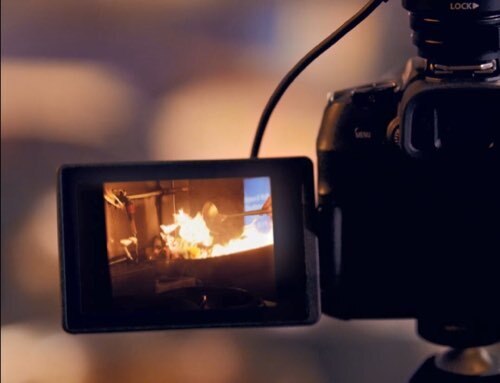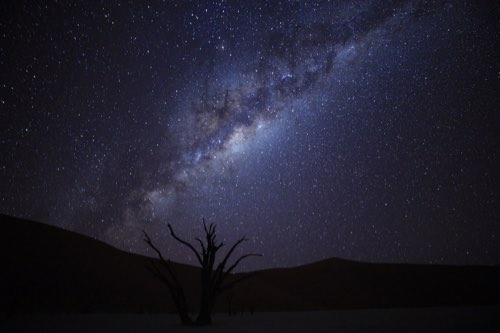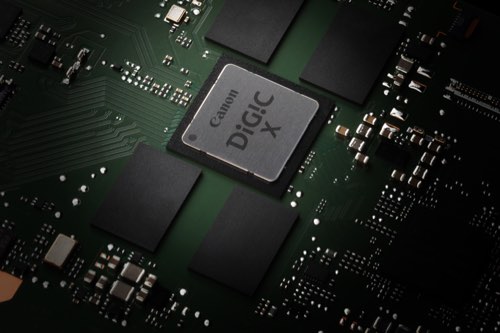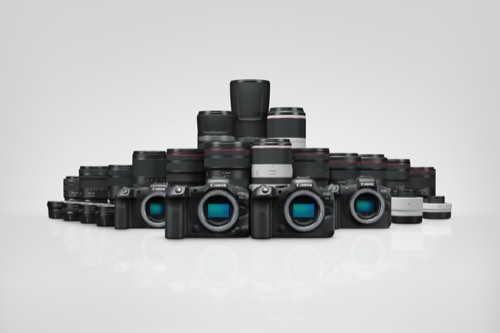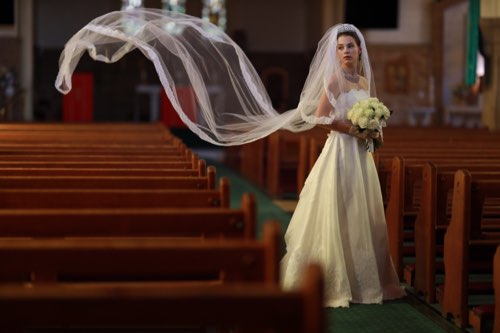A cinema camera is a huge investment, but necessary to take your filmmaking to the next level. Choosing one that is Netflix-approved ensures the best reliability and flexibility to give voice to your creative needs. Learn about the different Netflix-approved Cinema EOS cameras in this article.

What does "Netflix-approved camera" mean?
First things first: What does “Netflix-approved camera” mean?
A “Netflix-approved” camera is one that Netflix has authorised to be used as a primary camera for its Netflix Originals. 90% of a programme’s final total runtime must be captured on such cameras.
Such cameras must pass stringent internal evaluation by Netflix’s technical experts before they can be included on the “approved” list, so you can expect a high level of performance and reliability to support your creative needs. So even if you don’t foresee shooting a Netflix Original production anytime soon, choosing a Netflix-approved camera still has its advantages. And you'll be well-equipped if and when the Netflix Original opportunity calls!
The minimum specifications for Netflix approval
While meeting the minimum specifications does not guarantee that a camera will be approved by Netflix, all approved cameras have at least the following attributes:
- A true 4K UHD image sensor (during non-anamorphic shooting), with at least 3840 photosites along the width
- At least 10-bit colour depth
- Uncompressed/lightly compressed RAW video recording OR intraframe compressed codec with subsampling of 4:2:2 or greater.
- Minimum data rate of 240Mbps at 24 fps
- Scene-referred colour space
- Scene-referred transfer function (Log recording)
- Dedicated timecode output
Cameras with these specifications are capable of recording in formats that retain an immense amount of colour detail with minimal quality loss even with extensive post-production work. They also enable a colour-managed workflow, where colours look accurate across various displays and delivery formats throughout post-production.

A dedicated timecode terminal allows easy synchronisation of all the cameras and audio recorders in a multi-camera setup.
In addition, Netflix also evaluates the cameras for attributes such as:
- Dynamic range
- Form factor
- Workflow compatibility
- Stability
Find out more about how Netflix evaluates cameras in:
Approved Cameras – Behind the Scenes
Which Netflix-approved Cinema EOS camera to choose?
There are currently 10 Canon Cinema EOS cameras on Netflix’s approved list:
- EOS R5 C
- EOS C70
- EOS C80
- EOS C300 Mark II
- EOS C300 Mark III
- EOS C400
- EOS C500
- EOS C500 Mark II
- EOS C700
- EOS C700 FF


The cameras vary in terms of form factor, functionality, output capabilities, and budget. You should be able to find something that works for you, whether you are looking for a smaller DSLR-like body for run-and-gun shoots or a modular system that can be expanded for large-scale productions.
Here are more details about six of the latest cameras.
Comparison tables: 6 Netflix-approved Canon cinema cameras
Comparison of key features
Features common to all 6 models include:
- 4-channel audio
- 5-axis digital image stabilization
- Touchscreen operations
- Support both PQ and HLG HDR recording gammas
Other key differences are as below:
| Core features | ||||||
| R5 C | C70 | C80 | C300 Mark III | C400 | C500 Mark II | |
| Lens mount | RF | RF | RF | EF/PL | RF | EF/PL |
| Maximum resolution | 8K 60p | 4K DCI 60p | 6K 30p | 4K DCI | 6K 60p | 5.9K 60p |
| RAW recording | 8K 60p 5.9K 60p 2.9k 60p |
4K DCI 60p 2K 60p |
6K 30p 4.3K 60p |
4K DCI 60p 2K 60p (cropped) |
6K 60p Cropped: 4.3K 60p (Super 35) 2.1K 60p (Super 16) |
Cropless: 5.9K 60p/4.1K 60p (4:3)/3.7K 60p (6:5) Cropped: 4K DCI 60p (Super 35) 2K 60p (Super 16 ) |
| Sensor type | Full-frame CMOS | Super 35mm DGO | Full-frame BSI CMOS | Super 35mm DGO | Full-frame BSI CMOS | Full-frame |
| Processor | DIGIC X | DIGIC X | DIGIC DV7 | DIGIC DV7 | DIGIC DV7 | DIGIC DV7 |
| Video AF system | DPAF | DPAF | DPAF II | DPAF | DPAF II | DPAF |
| Dynamic range/Base ISO speeds | ||||||
| R5 C | C70 | C80 | C300 Mark III | C400 | C500 Mark II | |
| Dynamic range | 14+ stops | 16+ stops | 16 stops | 16+ stops | 16 stops | 15+ stops |
| Base ISO (C-Log recording/RAW) |
800 3200 |
800 | 800 3200 12800 |
800 | 800 3200 12800 |
800 |
| Recording modes | ||||||
| R5 C | C70 | C80 | C300 Mark III | C400 | C500 Mark II | |
| Canon Log modes | Canon Log 3 | Canon Log 2 & 3 | Canon Log 2 & 3 | Canon Log 2 & 3 | Canon Log 2 & 3 | Canon Log 2 & 3 |
| Internal recording formats | Cinema RAW light XF-AVC MP4 |
Cinema RAW Light XF-AVC MP4 |
Cinema RAW Light XF-AVC XF-AVC S XF-HEVC S |
Cinema RAW Light XF-AVC |
Cinema RAW Light XF-AVC XF-AVC S XF-HEVC S |
Cinema RAW Light XF-AVC |
| Slow/fast motion | 1-120p (4K, 2K) |
12-120p (4K) 12-180p (2K) |
1-120p (4K) 1-180p (2K) |
12-120p (4K) 12-180p (2K) |
1-120p (4K) 1-180p (2K) |
12-120p (2K, cropped) |
| Lenses | ||||||
| R5 C | C70 | C80 | C300 Mark III | C400 | C500 Mark II | |
| Anamorphic lens support | 2x / 1.8x / 1.3x | 2x / 1.3x | 2x / 1.8x / 1.3x | 2x / 1.8x / 1.3x | 2x / 1.8x /1.5x/ 1.3x | 2x / 1.8x / 1.3x |
| Lens terminal for Cine-Servo lenses | No | No | No | No (expansion unit required) |
Yes | No (expansion unit required) |
| Lenses supported | RF EF* |
RF EF* |
RF EF* PL* |
EF/PL** | RF EF* PL* |
RF EF* |
*Mount adapter required
** User changeable with mount change kit
| Form factor/mechanical features | ||||||
| R5 C | C70 | C80 | C300 Mark III | C400 | C500 Mark II | |
| Form factor | DSLR-like | DSLR-like | DSLR-like | Modular | Modular | Modular |
| Built-in ND filter | - | 10 stops | 10 stops | 10 stops | 10 stops | 10 stops |
| Built-in EVF | Yes | - | - | - | - | - |
| Terminals and interfaces | ||||||
| R5 C | C70 | C80 | C300 Mark III | C400 | C500 Mark II | |
| 12-G SDI output | No | No | Yes | Yes | Yes | Yes |
| MON. output | No | No | No | Yes | Yes | Yes |
| G-LOCK/SYNC | No | No | No | No (Expansion unit required) |
Yes | No (Expansion unit required) |
| XLR input terminals | No | Yes (Mini) |
Yes (Mini) |
Yes (Full-sized) |
Yes (Mini) |
Yes (Full-sized) |
| Built-in Wi-FI | Yes 2.4GHz / 5GHz |
No | Yes 2.4 GHz/ 5GHz |
No | Yes 2.4 GHz/ 5GHz |
No |
| Built-in ethernet terminal | No (WFT-R10 Wireless File Transmitter + Ethernet adapter required) |
No (Ethernet adapter required) |
Yes | No (Expansion unit required) |
Yes | No (Expansion unit required) |
| Multifunction shoe | Yes (x1) | No | Yes (x2) | No | Yes (x2) | No |
| Others | ||||||
| R5 C | C70 | C80 | C300 Mark III | C400 | C500 Mark II | |
| Card slots | CFexpress Type B x 1 SD UHS-II x 1 |
SD UHS-II x 2 | SD UHS-II x 2 | CFexpress Type B x 2 SD UHS-II x 1 |
CFexpress Type B x 1 SD UHS-II x 1 |
CFexpress Type B x 2 SD UHS-II x 1 |
| Native batteries | LP-E6NH | BP-A30/BP-A60* | BP-A30N/BP-A60N | BP-A30/BP-A60* | BP-A30N/BP-A60N | BP-A30/BP-A60* |
*Can also use BP-A30N/BP-A60N
1. The hybrid powerhouse: EOS R5 C

Outstanding features
- 45-megapixel full-frame CMOS image sensor
- RF mount
- 8K 60p RAW internal recording
- EVF
- AF and audio recording (.wav file) at high frame rates
- Eye Detection AF & EOS iTR AF X tracking
- Multi-function hot shoe mount
Considered Canon’s first true hybrid camera, the EOS R5 C is the most compact and lightweight in the Cinema EOS lineup and also its smallest cinema camera with a full-frame sensor. It shoots up to 8K 60p RAW internally, which provides future-proofing as well as extra post-production flexibility. On top of all that, it is also a powerful, 45-megapixel still photography camera, boasting the same performance as the EOS R5.

The multi-function shoe supports external audio accessories such as XLR microphones.

The electronic viewfinder aids vision when shooting under bright sunlight, where the glare can make it hard to see the rear LCD screen or an external monitor.
2. Compact versatility: EOS C70

Outstanding features
- Compact DSLR-like form factor
- Dual Gain Output (DGO) sensor
- RF mount
- Eye Detection AF & EOS iTR AF X tracking
- AF and audio recording at high frame rates
- 2 mini-XLR input terminals
The EOS C70 has many similarities with the EOS R5 C, including a DSLR-like form factor, the new RF lens mount, and Eye Detection AF and EOS iTR AF X subject tracking. However, it has a larger 16+-stop dynamic range due to the Dual Gain Output (DGO) technology used in its 4K Super 35mm image sensor, thus generating cleaner HDR output. It offers extensive options for simultaneous recording to its two SD cards. Audio recording at normal frame rates is possible during high frame rate 4K 120p recording.

The EOS C70 features built-in options such as a 10-stop ND filter, also found on higher-end Cinema EOS cameras, and two mini-XLR terminals that allow more accessories to be connected.

EF lenses can be attached via the Mount Adapter EF-EOS R 0.71x, which allows users to enjoy the lens at its original focal length. It also allows for a 1-stop gain in light transmission.
3. A new generation of versatility: EOS C80

Outstanding features
- 6K full-frame back-illuminated stacked CMOS sensor
- Built-in Wi-Fi and Ethernet terminal
- Triple-base ISO (800/3200/12800)*
- Dual Pixel CMOS AF II
- Industry-standard XF-HEVC S and XF-AVC S codecs
- Supports PL lenses with optional Mount Adapter PL-RF
- 12G-SDI Out terminal
*With Canon Log 2/3 and RAW recording at HDMI RAW setting
The EOS C80 packs even more into its portable DSLR-style form factor, offering a leap in capabilities over the EOS C70. It boasts a high-resolution 6K full-frame back-illuminated (BSI) stacked CMOS sensor that offers not only greater imaging possibilities but also a faster signal readout that minimises rolling shutter distortion; triple-base ISO for improved noise reduction; and the powerful new deep-learning-based Dual Pixel CMOS AF II autofocus system, which can detect and track subjects over approximately 100% x 100% of the image frame.
The addition of interfaces such as a new 12G-SDI output terminal, ethernet terminal, internal Wi-Fi and the new Multi-function shoe improve expandability and connectivity, making the cameras ready for diverse production workflows such as remote camera operation and virtual production.

The EOS C80 adds an 12G-SDI output terminal that was previously available only on more advanced models such as the EOS C500 Mark II, C400, and EOS C300 Mark III. It enables 4K 50p/60p output over a single cable, providing a robust transmission option for production sets that require high-resolution and high-frame-rate workflows.

Triple Base ISO lets you use the base ISO setting that maintains the best dynamic range for the scene, resulting in footage with less noise and better image quality.
Learn more about the EOS C80 in:
EOS C80: Redefining Versatility for the Modern Creator
4. Taking filmmaking to a higher level: EOS C300 Mark III

Outstanding features
- Super 35mm 4K Dual Gain Output (DGO) sensor
- Compact, versatile modular design
- EF mount
- Optional PL/EF Cinema Lock mount (user-changeable)
- 12G-SDI Out terminal
- Full-size XLR terminals
- Dual CFexpress Type B cards
Cinema cameras with a modular body system like the EOS C300 Mark III allow greater flexibility to configure the camera to your needs, scaling up or down as necessary. In its most basic configuration, the EOS C300 Mark III is compact enough for handheld shooting and can be easily rigged to a gimbal or drone. Optional extension units can be purchased for various production requirements such as live productions and multi-camera broadcasts.

On both the EOS C300 Mark III and EOS C500 Mark II, you can change the default EF mount to a PL mount or EF Cinema Lock mount (sold separately) on your own, without having to take the camera to a service centre.

In its bare bones configuration, the EOS C300 Mark III can be easily rigged onto a drone.
5. Unlocking greater production possibilities: EOS C400

Outstanding features
- 6K full-frame back-illuminated stacked CMOS sensor
- Triple base ISO
- 12-pin LENS terminal (to power cine-servo/broadcast lenses)
- Built-in G-LOCK/SYNC terminal
- 12G-SDI Out terminal
- Industry-standard XF-HEVC S and XF-AVC S codecs
- Supports PL lenses with optional Mount Adapter PL-RF
While the EOS C400 shares many features with the EOS C80, it adds advanced expandability that caters to broadcasting and high-budget productions, making it an excellent investment for filmmakers, creators, and production houses with bigger dreams. Its built-in Wi-Fi, ethernet terminal, and G-LOCK/SYNC terminal give it the best out-of-the-box connectivity out of the three modular camera systems on this list.

The EOS C400’s advanced interfaces support broadcast, and live productions without an expansion unit. Besides the MON. and G-LOCK/SYNC/RET terminals, there is a 12-pin LENS terminal conveniently located on the camera front for direct power delivery to compatible Cine-Servo and broadcast lenses.

PL-mount lenses such as Sumire Prime lenses can be mounted easily and securely without extra tools using the optional Mount Adapter PL-RF.
6. Full frame, full flexibility: EOS C500 Mark II

Outstanding features
- 5.9K full-frame CMOS sensor
- EF mount
- Dual CFexpress Type B cards
- Netflix approved for anamorphic capture
- Optional PL/EF Cinema Lock mount (user-changeable)
- 12G-SDI Out terminal
- Full-size XLR terminals
For users who prefer an EF mount camera, the EOS C500 Mark II’s 5.9K full-frame sensor is the key difference that sets it apart from the EOS C300 Mark III. It is also currently the only Canon camera that Netflix has approved for anamorphic capture.

Full-size XLR terminals provide a sturdier, more durable connection. You won’t need adapters if your existing supporting/audio equipment uses standard XLR connectors.

The EOS C500 Mark II’s dual CFexpress Type B card slots are perfect for high bitrate recording needs, as well as simultaneous and relay recording.
Get in touch to find out more about these cameras!








